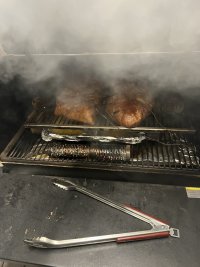First, how do you know your cook temperature was 375 degees F. If you read posts on the forum, you will soon learn that the temperature controller readout is notoriously inaccurate. If I set my Ironwood controller at 375 F, the actual cook temperature will be closer to 340 F, but with some grills the cook temperature might be hotter than the controller indicates.
You need to obtain a 3rd party thermometer to check the actual cook temperature. I drilled a hole through the lid of my Ironwood to mount an analog grill thermometer like you find on most gas grills, charcoal grills and offset smokers. Once you learn how your specific smoker operates, you won't necessarily need the 3rd party thermometer for cook temperature as you will learn where to set the controller to get the desired cook temperature. You can also use a wireless probe situated just above the cooking grate, but not touching the grate.
Always use a 3rd party instant read thermometer you know to be accurate to check the internal meat temperature. I used the Traeger internal meat probe for dmy first cook and have not plugged it in since. A few degrees of difference in the internal temperature can determine whether beef turns out medium rare of medium well. Get a thermometer you can trust. One that will read in under 3 seconds is ideal as you need to check temperatures in multiple spots on the protein. If you get a probe that takes 10 seconds to read, you will soon be frustrated. Remember that the longer you leave the lid open, the more heat is being lost. As they say, when you're lookin', you ain't cookin'. You want to be able to check the cook quickly. While the Thermoworks Thermapen comes highly recommended by professional chefs and many back yard pitmasters, it is not necessary to spend $100 to get a perfectly adequate instant read probe. Just read specifications and reviews carefully for any device you plan to purchase.
When I used to cook burgers on a gas grill, I often got grease fires. The same thing happens in a charcoal grill. If grease drips on anything that is above 450 F, the grease can ignite. If you are trying to cook at 375 F, the drip tray and flame shield will be above 450F. If the grease falls onto the Traeger drip tray, it can be hot enough to ignite the grease, just as in a gas grill. In the Traeger, you can minimize the likelihood of a grease fire by placing the burgers on the top rack and placing a pan on the bottom shelf to catch grease drippings. However, this might not be hot enough to develop the brown crust you desire. The ideal temperature for searing steaks and burgers is 450F and higher. At this temperature, grease fires are likely to occur.
The Traeger is best described as a convection oven with wood smoke. It is ideal for cooking things low and slow. Some people do use their Traeger for cooking hot and fast by purchasing GrillGrates that concentrate the heat to properly sear burgers and steaks. Gas grills, charcoal grills, and gas griddles are much better suited for hot and fast cooks than the Traeger. When I first purchased my Ironwood, I still had an old gas grill. I used the gas grill to cook burgers, brats and to sear steaks that had first been smoked on the Traeger. This year I decided to replace the old gas grill with a gas griddle. I use the Traeger smoker for low and slow cooks and the griddle for hot and fast. I often smoke steaks for a while until they reach an internal temp of 125F (rare) and then move them to the griddle for searing until they reach my desired internal temp of 141F, but of course your preference on temperature might differ.
You can also get a propane blow torch for searing after a low and slow cook. Some forum members have the Grillblazer Sous-Vide gun, but it is rather expensive. If you do a lot of steaks, it might be worth it. There are less expensive blow torches that can be used, but I doubt they are the same quality as the Grillblazer torches.
No single outdoor cooking appliance or method is ideal for every situation. The great thing about the Traeger is that it is well designed to do an unattended overnight cook for things like brisket and pork shoulder. It is also great for smoking a turkey or whole chicken. It can also do a great job of cooking pizza, baking bread, and roasting vegetables. However, it is not ideal for grilling burgers or searing steaks, although it can be done with some modifications.
Before you return your Traeger, read some of the posts on this forum and learn how others are using their Traegers. When used appropriately, they can produce some fantastic meals, but there is a learning curve. The first cook on a Traeger is unlikely to go well. My first cook was grilled chicken breasts. They turned out as tough as shoe leather. Since then, I have learned how to cook chicken breasts so they turn out tender and juicy, but there was a learning process. I cooked some earlier this week and they were great.
Do not give up without a fight. You can suceed with the help of others on the forum. There are quite a few great folks here who are more than willing to help you through your beginner struggles.









